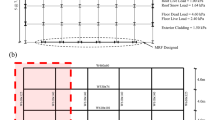Abstract
The objective of this paper was to evaluate the influence of initial flaws in the beam-column connections on the seismic performance of steel frame structures. The finite element models were constructed with different initial flaw lengths by ABAQUS. The initial flaw length was 0, 8, and 16 mm, respectively. The dynamic elastic-plastic time history analysis and the pushover analysis were conducted to obtain the probabilistic characteristics of seismic demand and seismic capacity. Seismic demands are quantified in terms of the maximum drift angle (RDA) and the displacement ductility ratio \( \left( {\mu_{d} } \right) \). Moreover, the peak ground acceleration (PGA) was used for the pushover analysis. Formulas considering the influence of initial flaws on failure probability of a structure were derived for each length using different design basic acceleration of ground motion. The fragility curves were further constructed based on the data of seismic demand and capacity. The results show that the fragility of steel frame structures is similar across different seismic demand parameters. In addition, the analyses of fragility curves obviously indicate that the seismic fragility of steel frame structures increases as flaw length increases. Finally, the fragility of steel frame structures with initial flaws is consistent using different design basic acceleration of ground motion.







Similar content being viewed by others
References
AISC. (1994). In Proceedings of the AISC special task committee on the Northridge earthquake. American Institute of Steel Construction, Chicago.
ATC. (1991). Seismic vulnerability and impact of disruptions of lifelines in the conterminous United States. ATC Report No. ATC-25, Redwood City, California.
ATC. (1996). Seismic evaluation and retrofit of concrete buildings. ATC Report No. ATC-40, California.
Chen, Z. H. (2014). Seismic performance evaluation of existing RC frame structure. Ph.D. Dissertation, Qingdao University of Technology.
Chi, W. M., Deierlein, G. G., & Ingraffea, A. (2000). Fracture toughness demands in welded beam-column moment connections. Journal of Structural Engineering, 126(1), 88–97.
EN 1998-3-2005. (2005). Eurocode 8: design of structures for earthquake resistance. Part 3: Assessment and retrofitting of buildings. Brussels: European Committee for Standardization.
FEMA. (1997). NEHRP guidelines for the seismic rehabilitation of buildings. FAME Publication 273, Washington D.C.
FEMA. (1999). HAZUS99 User’s Manual. Washington D.C.
GB, T 50011–2010. (2010). Code for seismic design of buildings. Beijing: China Architecture & Building Press.
Hu, F. X., Shi, G., & Shi, Y. J. (2017). Experimental study on seismic behavior of high strength steel frames: Global response. Engineering Structures, 131, 163–179.
Hwang, H., Liu, J. B., & Chiu, Y. H. (2001). Seismic fragility analysis of highway bridges. Memphis: Center for Earthquake Research and Information, University of Memphis.
Joh, C., & Chen, W. F. (1999). Fracture strength of welded flange-bolted web connections. Journal of Structural Engineering, 125(5), 565–571.
Kauffmann, E. J. and Fisher, J. (1996). Fracture analysis of failed moment frame weld joints produced in full-scale laboratory tests and buildings damaged in the Northridge earthquake. Technical report SAC-95-08, (pp. 1–21).
Mackie, K. R. (2005). Fragility basis for California highway overpass bridge seismic decision making. Ph.D. Dissertation, University of California Berkeley.
Noroozinejad, F. E., Hashemi, R. F., Talebi, M., et al. (2014). Seismic risk analysis of steel-MRFs by means of fragility curves in high seismic zones. Advances in Structural Engineering, 17(9), 1227–1240.
Orsini, G. (1999). A model for buildings’ vulnerability assessment using the parameter less scale of seismic intensity (PSI). Earthquake Spectra, 15(3), 463–483.
Park, J., & Kim, J. (2010). Fragility analysis of steel moment frames with various seismic connections subjected to sudden loss of a column. Engineering Structures, 32(6), 1547–1555.
Rossetto, T., & Elnashai, A. S. (2003). Derivation of vulnerability functions for European-type RC structures based on observational data. Engineering Structures, 25(10), 1241–1263.
Rota, M., Penna, A., & Magenes, G. (2010). A methodology for deriving analytical fragility curves for masonry buildings based on stochastic nonlinear analyses. Engineering Structures, 32(5), 1312–1323.
SAC. (1995). Interim guidelines: evaluation, repair, modification and design of welded steel moment frame structures. Report FEMA No. 267/SAC-95-02, SAC Joint Venture, Sacramento, California.
Shinozuka, M., Feng, M. Q., Lee, J., & Naganuma, T. (2000). Statistical analysis of fragility curves. Journal of Mechanical Engineering, 126(12), 1224–1231.
Singhal, A., & Kiremidjian, A. S. (1998). Bayesian updating of fragilities with application to RC Frames. Journal of Structural Engineering, 124(8), 922–929.
Tenchini, A., Aniello, M. D., Rebelo, C. R., et al. (2014). Seismic performance of dual-steel moment resisting frames. Journal of Constructional Steel Research, 101, 437–454.
Villani, A., Castro, J. M., & Elghazouli, A. Y. (2009). Improved seismic design procedure for steel moment frames. STESSA 2009: Behaviour of Steel Structures in Seismic Areas, Philadelphia.
Wang, D. (2006). Seismic fragility analysis and probabilistic risk analysis of steel frame structures. Ph.D. Dissertation, Harbin Institute of Technology.
Wang, Y. B., Li, G. Q., Cui, W., et al. (2014). Seismic behavior of high strength steel welded beam-column members. Journal of Constructional Steel Research, 102, 245–255.
Xu, G. Q., & Ellingwood, B. (2011). Probabilistic robustness assessment of Pre-Northridge steel moment resisting frames. Journal of Structural Engineering, 137(9), 925–934.
Yu, X..H. (2012). Probabilistic seismic fragility and risk analysis of reinforced concrete frame structures. Ph.D. Dissertation, Harbin Institute of Technology.
Acknowledgements
This work was financially supported by the National Natural Science Foundation of China (No. 51778143), the Priority Academic Program Development of Jiangsu Higher Education Institutions (No. CE02-1-51), and the Research & Innovation Project for College Graduates of Jiangsu Province of China (No. KYLX15_0211).
Author information
Authors and Affiliations
Corresponding author
Rights and permissions
About this article
Cite this article
Zuo, Y., Li, W. & Li, M. Seismic Fragility Analysis of Steel Frame Structures Containing Initial Flaws in Beam-Column Connections. Int J Steel Struct 19, 504–516 (2019). https://doi.org/10.1007/s13296-018-0135-6
Received:
Accepted:
Published:
Issue Date:
DOI: https://doi.org/10.1007/s13296-018-0135-6




